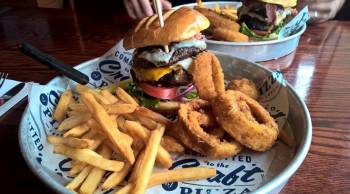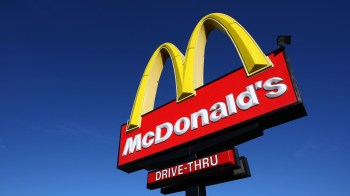TEXT OF INTERVIEW
Kai Ryssdal: I don’t know if you saw the video today, but President Obama and Vice President Biden went out to eat for their weekly lunch date today. A burger joint in Northern Virginia. We don’t really get a lunch break here, what with getting the program on the air and all, so last week after work some of us decided to grab a burger not far from my house at a local chain called In-N-Out Burger.
RYSSDAL: Hi.
COUNTER GIRL: Hi. How are you doing today?
RYSSDAL: I’m good, thanks. I would like a cheeseburger animal style, fries and a root beer. And my friend here?
STACY PERMAN: I’ll have a grilled cheese animal style and a diet coke.
COUNTER GIRL: All right, that’ll be $8.43 please.
My lunch date was Stacy Perman. She writes for Businessweek magazine. And she’s got a new book about In-N-Out. The company’s privately held. Relatively small. Just a couple of hundred stores in four states — all out West. But it is something of a cultural marker. The menu’s pretty simple: burgers, fries, sodas and shakes. Perman points out though that you can mix it up. Like that animal-style burger. Mustard cooked into the meat with pickles and grilled onions.
PERMAN: Something that a lot of people don’t know about is the animal-style french fries. You might have to go to food rehab afterwards. It’s not a healthy choice.
But broken into parts the ingredients, Perman says, are as healthy as you’re gonna get for fast food.
PERMAN: They have their own butcher line. They make sure their beef patties are fresh. They make them themselves and deliver them to the stores. They bake their own buns. The fries are handcut, and everything is made to order. They also treat their employees incredibly well. If you’re a part-time worker today you make $10 an hour. And store managers that meet their goals, the company takes them on first-class trips abroad to Europe, Caribbean cruises. They’re very generous.
Ryssdal: I’m definitely in the wrong line of work. Tell me about the couple that started this chain.
PERMAN: That would be Harry and Esther Snyder. She was the daughter and grand-daughter of coal miners. And he was the son of Dutch immigrants that didn’t, you know, make a lot of money during their lives. And he was the classic entrepreneur. At the time when they started In-N-Out in 1948 in Baldwin Park, Calif., that was the time of the car hops and the big drive-ins and the kitschy architecture. But the Snyders didn’t have a lot money, so they only had a very small plot of land with no indoor seating even. So Harry was an electronics enthusiast, and he came up with this two-way speaker phone, which is basically the prototype for what became today’s drive-thru.
Ryssdal: There is a very strong corporate culture here, too. I mean, they are very set in their ways. And how they do things and what they want this store to be.
PERMAN: Definitely. That started from the very beginning with the Snyders. Their business philosophy was based on three words: quality, cleanliness and service.
EMPLOYEE: How was everything guys?
RYSSDAL: It was delicious. As always. Thank you.
EMPLOYEE: You want me to get rid of that? Are you all good?
RYSSDAL: You know, I’m going to pick at the fries for a while. Thanks.
PERMAN: I mean how many fast-food restaurants do you know that the wait staff comes to you and sees if you need anything and wants to clean up after you?
Ryssdal: That’s a good point. How involved were the Snyders once this place got big?
PERMAN: Micro-managers. Particularly Harry. I mean in the beginning he actually would go to his meat purveyors, stand over him, and watch him cut up the beef to make sure he got what he ordered. And Esther until her dying days, she would have her driver take her to the drive-thrus, wouldn’t announce herself, order a burger, sit in the parking lot, take it apart, make sure it was constructed correctly. She was really involved.
Ryssdal: You know when I moved out here I discovered two things that you couldn’t get back East. One was Trader Joe’s, which you now can, the other one is In-N-Out burgers. For those guys in New York and on the East coast whose mouths are watering right now at the prospect of a hamburger animal style, what are the prospects for more expansion to other parts of the country and the world?
PERMAN: Well, here’s the thing, they’ve expanded slowly for a few reasons. One is the fact that, as I said, they have butchers that create the beef, they have these commissaries. They don’t open a store outside a 500-mile radius from one of these commissaries, so they can deliver the fresh goods on a daily basis. They could go to New York. But let’s put it this way, they opened their fourth state, Utah, 60 years after opening, so that’s not anybody’s Sherman’s March on Atlanta, by any stretch of the imagination.
Ryssdal: Well, Stacy Perman, thank you so much for your time.
PERMAN: Thank you.
There’s a lot happening in the world. Through it all, Marketplace is here for you.
You rely on Marketplace to break down the world’s events and tell you how it affects you in a fact-based, approachable way. We rely on your financial support to keep making that possible.
Your donation today powers the independent journalism that you rely on. For just $5/month, you can help sustain Marketplace so we can keep reporting on the things that matter to you.


















